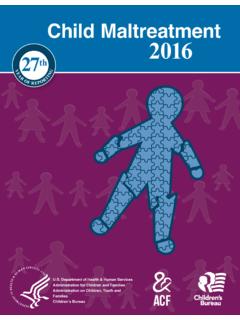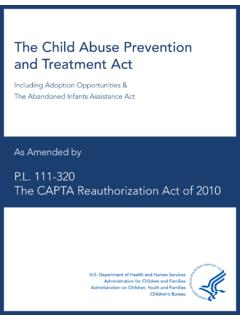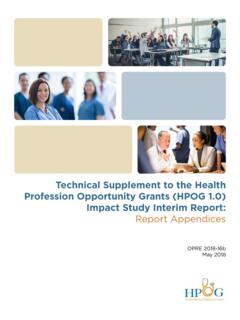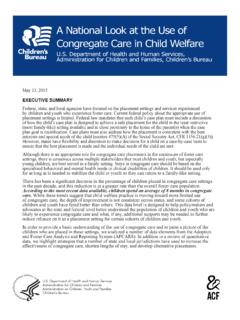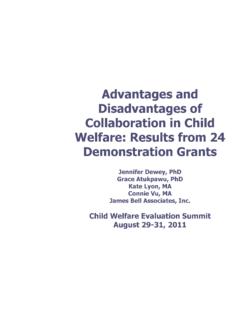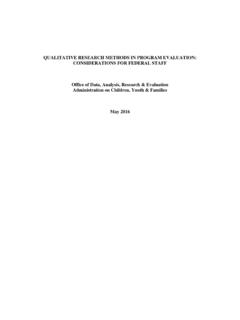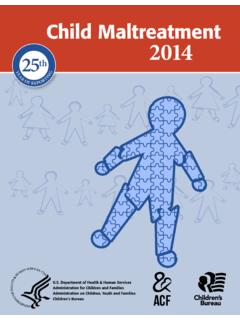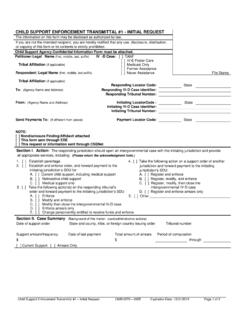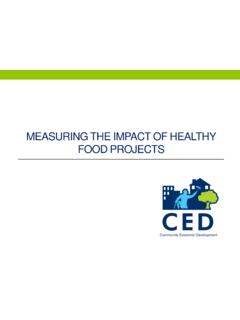Transcription of Child Maltreatment 2012
1 YEAR OF REPORTING23rdChild Department of Health & Human ServicesAdministration for Children and FamiliesAdministration on Children, Youth and FamiliesChildren s BureauThis report was prepared by the Children s Bureau (Administration on Children, Youth and Families, Administration for Children and Families) of the Department of Health and Human Services. Assistance was provided by Walter R. McDonald & Associates, Inc. (Contract Order HHSP233201200657G). This report also is available on the Children s Bureau website at you have questions or require additional information about this report , please contact the Child Welfare Information Gateway at or 1 800 394 use files of the NCANDS data are archived at the National Data Archive on Child abuse and Neglect (NDACAN) at Cornell University.
2 Researchers who are interested in using these data for statistical analyses may contact NDACAN by phone at 607 255 7799, by email at or on the Internet at ht t Please note that NDACAN serves as the repository for the NCANDS data sets, but is not the author of the Child Maltreatment report contained in this publication is in the public domain and may be reproduced, fully or partially, without permission of the Federal Government. The courtesy of attribution, crediting the source of the material, is requested. The recommended citation Department of Health and Human Services, Administration for Children and Families, Administra-tion on Children, Youth and Families, Children s Bureau.
3 (2013). Child Maltreatment 2012. Available from NCANDS Contracting Officer s Representative may be reached at the following address:Kurt Heisler Office of Data, Analysis, Research, and Evaluation Administration on Children, Youth and Families 1250 Maryland Avenue, SW 8th Floor Washington, DC 20024 MaltreatmentDEPARTMENT OF HEALTH & HUMAN SERVICESADMINISTRATION FOR CHILDREN AND FAMILIESA dministration on Children, Youth and Families1250 Maryland Avenue, SW, Washington, 20024 Letter from the Associate Commissioner: I am pleased to present Child Maltreatment 2012. This is the 23rd edition of the annual report on Child abuse and neglect data collected via the National Child abuse and Neglect Data System (NCANDS).
4 This report is based on federal fiscal year 2012 data submitted by 49 states, the District of Columbia, and the Commonwealth of Puerto Rico. The report reflects our commitment to provide the most complete national information about children and families known to states Child protective services (CPS) agencies. Key findings in this report include: From 2008 to 2012, overall rates of victimization declined by percent, from to per 1,000 children in the population. This results in an estimated 30,000 fewer victims in 2012 (686,000) compared with 2008 (716,000). Since 2008, overall rates of children who received a CPS response increased by percent, from to per 1,000 children in the population.
5 This results in an estimated 107,000 additional children who received a CPS response in 2012 (3,184,000) compared to 2008 (3,077,000). Nationally, four-fifths ( ) of victims were neglected, percent were physically abused, percent were sexually abused and percent were psychologically maltreated. For 2012, a nationally estimated 1,640 children died of abuse and neglect at a rate of children per 100,000 children in the national population. The Child Maltreatment 2012 report includes national- and state-level findings about investiga-tions and assessments, perpetrators of Maltreatment , and prevention and postinvestigation services. I hope you continue to find this report useful and informative.
6 The document is available from the Children s Bureau website at technology/statistics-research/ Child -mal treatment. If you have any questions or require additional information about either the Child Maltreatment 2012 report or about Child Maltreatment in general, please contact the Child Welfare Information Gateway at or 1 800 394 ,/s/JooYeun Chang Associate Commissioner Children s Bureau iiChild Maltreatment 2012 AcknowledgementsThe Administration on Children, Youth and Families (ACYF) strives to ensure the well-being of our Nation s children through many programs and activities. One such activity is the National Child abuse and Neglect Data System (NCANDS) of the Children s Bureau.
7 National and state statistics about Child Maltreatment are derived from the data collected by Child protective services agencies and reported to NCANDS. The data are analyzed, dissemi-nated, and released in an annual report . Child Maltreatment 2012 marks the 23rd edition of this report . The administration hopes that the report continues to serve as a valuable resource for policymakers, Child welfare practitioners, researchers, and other concerned citizens. This year s national statistics were based upon receiving data from 51 states, including the District of Columbia and the Commonwealth of Puerto Rico. Case-level data were received from all 51 states that submitted data.
8 ACYF wishes to thank the many people who made this publication possible. The Children s Bureau has been fortunate to collaborate with informed and committed state personnel who work hard to provide comprehensive data, which reflect the work of their agencies. ACYF gratefully acknowledges the priorities that were set by state and local agencies to submit these data to the Children s Bureau, and thanks the caseworkers and supervisors who contribute to and use their state s information system. The time and effort dedicated by these and other individuals are the foundation of this successful federal-state partnership. Acknowledgements iiiChild Maltreatment 2012 ContentsLetter from the Associate Commissioner iiAcknowledgements iiiSummaryixChapter 1: Introduction 1 Background of NCANDS 1 annual Data Collection Process 2 NCANDS as a Resource 3 Structure of the report 4 Chapter 2: Reports 5 Screening of Referrals 5 report Dispositions 6 report Sources 7 CPS Response Time 8 CPS Workforce and Caseload 8 Exhibit and Table Notes 9 Chapter 3.
9 Children 16 Alternative Response 17 Unique and Duplicate Counts 17 Children Who Received a CPS Response 18 Children Who Were Subjects of a report 18 Number of Child Victims 19 Child Victim Demographics 19 Maltreatment Types 20 Maltreatment Types by Age 20 Risk Factors 21 Perpetrator Relationship21 Federal Standards and Performance Measures 22 Exhibit and Table Notes 22 Chapter 4: Fatalities51 Number of Child Fatalities 51 Child Fatality Demographics 52 Maltreatment Types 53 Perpetrator Relationship53 Risk Factors 53 Prior CPS Contact 54 Exhibit and Table Notes 54 Contents ivChild Maltreatment 2012 Chapter 5: Perpetrators 61 Number of Perpetrators 61 Perpetrator Demographics 61 Maltreatment Types 62 Perpetrator Relationship 62 Exhibit and Table Notes 63 Chapter 6: Services 74 Prevention Services 74 Postresponse Services 76 History of Receiving Services 77 Exhibit and Table Notes 78 Chapter 7: Reports, Research, and Capacity Building Activities Related to Child Maltreatment 90 Reports on National Statistics 90 Research on Child Maltreatment 92 Capacity Building Initiatives 94 The Future of NCANDS and Suggestions for Future Research 103 Appendix A: Required CAPTA Data Items 105 Appendix B: Glossary 107 Appendix C: State Characteristics 123 Appendix D.
10 State Commentary 130 Endnotes 248 Contents vChild Maltreatment 2012 ExhibitsExhibit S 1 Statistics at a Glance, 2012 xiiiExhibit 2 A Referral Rates, 2008 2012 6 Exhibit 2 B report Disposition Rates, 2008 2012 7 Exhibit 3 A Child Disposition Rates, 2008 201218 Exhibit 3 B Children Who Were Subjects of a report by Disposition, 2012 18 Exhibit 3 C Child Victimization Rates, 2008 2012 19 Exhibit 3 D Victims by Age, 201220 Exhibit 3 E Selected Maltreatment Types of Victims by Age, 2012 21 Exhibit 4 A Child Fatality Rates per 100,000 Children, 2008 201252 Exhibit 4 B Child Fatalities by Sex, 201252 Exhibit 4 C Child Fatalities by Race and Ethnicity, 201253 Exhibit 4 D Maltreatment Types of Child Fatalities, 201253 Exhibit 4 E Child Fatalities With Selected Caregiver Risk Factors, 201254 Exhibit 5 A Perpetrators by Age, 201262 Exhibit 5 B Perpetrators by Race and Ethnicity, 201262 Exhibit 5 C Perpetrators by Maltreatment Type, 2012 62 Exhibit 5 D Perpetrators by Relationship to Their Victims, 2012 63 Exhibit 6 A Reported Maltreatment Types of Victims Who Received Foster Care and In-Home Services, 2012 77 Contents viChild Maltreatment 2012 TablesTable 2 1 Screened-In and Screened-Out Referrals, 2012 11 Table 2 2 report Sources, 2008 2012 12 Table 2 3 CAPTA Performance Measure.
